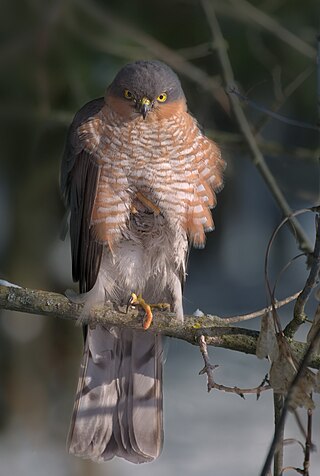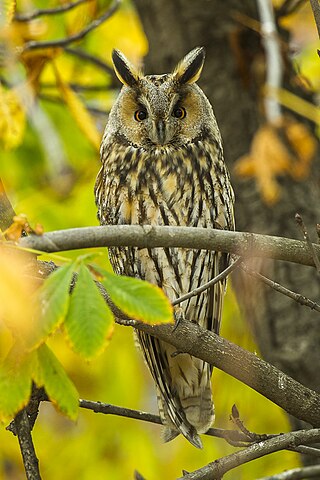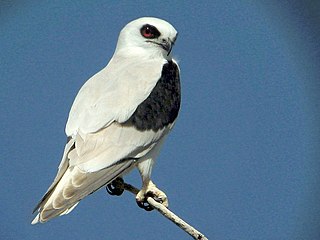
A plucking post is a raised structure such as a tree stump which is used regularly by a bird of prey to dismember its prey, removing feathers and various other inedible parts before eating it. [1]

A plucking post is a raised structure such as a tree stump which is used regularly by a bird of prey to dismember its prey, removing feathers and various other inedible parts before eating it. [1]


The elevated nature of the post allows for a safer landing with the heavy load of the prey, as well as being a good vantage point to scan for other predators, while the bird is vulnerable, involved in the relatively complex process of plucking and feeding on its prey.
Many owls use plucking posts for prey that has been caught on the ground. Barred owls often use old nests for the purpose. [2] Plucking posts are used by barn owls which hunt by flying low and slowly over an area of open ground, hovering over spots that conceal potential prey. The barn owl feeds primarily on small vertebrates, particularly rodents. The common buzzard is another user of plucking posts and has an even more varied diet than the barn owl. The sparrowhawk flies low over the ground, skimming hedges and fences, but staying close to cover so that it can rapidly pounce on its victims. In woodland its agility enables it to fly swiftly between the trunks and branches. [3]
In New Zealand the New Zealand falcon takes its catch to a plucking post to dislocate the bird's neck using the notch on its bill that all falcons have. It then plucks the feathers before eating the entire bird. [4]
Plucking posts are ideal places for setting up bird hides, thus allowing a close observation of bird of prey feeding behaviour.


The post provides a firm surface for an effective grip by the bird's talons and sometimes crevices for helping with the mechanical separation of the prey. Natural tree stumps and man-made structures such as straining and fence posts. Boulders may be used, especially if they have a carpet covering of moss or are cracked or ribbed.
Bird pellets are often found on or around plucking posts, composed of the indigestible items that were consumed by the predator.
Plucking posts, surrounded by feathers and fur, may indicate that a raptor nesting site is nearby and these may be mainly used during the breeding season.
Scientists can use the evidence of plucking posts to provide information about the feeding behaviour of relevant raptors. [5]
It has also been suggested that faeces marks and plucking may represent a widespread method for communicating current reproduction and territory to conspecifics. [6]
In secure or difficult surroundings the plucking post may be at ground level.



The common buzzard is a medium-to-large bird of prey which has a large range. It is a member of the genus Buteo in the family Accipitridae. The species lives in most of Europe and extends its breeding range across much of the Palearctic as far as northwestern China, far western Siberia and northwestern Mongolia. Over much of its range, it is a year-round resident. However, buzzards from the colder parts of the Northern Hemisphere as well as those that breed in the eastern part of their range typically migrate south for the northern winter, many journeying as far as South Africa.

Birds of prey or predatory birds, also known as raptors, are hypercarnivorous bird species that actively hunt and feed on other vertebrates. In addition to speed and strength, these predators have keen eyesight for detecting prey from a distance or during flight, strong feet with sharp talons for grasping or killing prey, and powerful, curved beaks for tearing off flesh. Although predatory birds primarily hunt live prey, many species also scavenge and eat carrion.

Barn-owls are one of the two families of owls, the other being the true owls or typical owls, Strigidae. They are medium to large owls with large heads and characteristic heart-shaped faces. They have long, strong legs with powerful talons. They also differ from the Strigidae in structural details relating in particular to the sternum and feet.

The Accipitridae is one of the four families within the order Accipitriformes, and is a family of small to large birds of prey with strongly hooked bills and variable morphology based on diet. They feed on a range of prey items from insects to medium-sized mammals, with a number feeding on carrion and a few feeding on fruit. The Accipitridae have a cosmopolitan distribution, being found on all the world's continents and a number of oceanic island groups. Some species are migratory. The family contains 256 species which are divided into 12 subfamilies and 75 genera.

The Eurasian sparrowhawk, also known as the northern sparrowhawk or simply the sparrowhawk, is a small bird of prey in the family Accipitridae. Adult male Eurasian sparrowhawks have bluish grey upperparts and orange-barred underparts; females and juveniles are brown above with brown barring below. The female is up to 25% larger than the male – one of the greatest size differences between the sexes in any bird species. Though it is a predator which specialises in catching woodland birds, the Eurasian sparrowhawk can be found in any habitat and often hunts garden birds in towns and cities. Males tend to take smaller birds, including tits, finches and sparrows; females catch primarily thrushes and starlings but are capable of killing birds weighing 500 g (18 oz) or more.

The rough-legged buzzard (Europe) or rough-legged hawk is a medium-large bird of prey. It is found in arctic and subarctic regions of North America, Europe, and Asia during the breeding season, and migrates south for the winter. Historically, it was also known as "rough-legged falcon" in such works as John James Audubon's The Birds of America.

The long-eared owl, also known as the northern long-eared owl or, more informally, as the lesser horned owl or cat owl, is a medium-sized species of owl with an extensive breeding range. The genus name, Asio, is Latin for "horned owl", and the specific epithet, otus, is derived from Greek and refers to a small eared owl. The species breeds in many areas through Europe and the Palearctic, as well as in North America. This species is a part of the larger grouping of owls known as typical owls, of the family Strigidae, which contains most extant species of owl.

The great grey owl is a true owl, and is the world's largest species of owl by length. It is distributed across the Northern Hemisphere, and it is the only species in the genus Strix found in both Eastern and Western Hemispheres. In some areas it is also called the Phantom of the North, cinereous owl, spectral owl, Lapland owl, spruce owl, bearded owl, and sooty owl.

The Life of Birds is a BBC nature documentary series written and presented by David Attenborough, first transmitted in the United Kingdom from 21 October 1998.

The New Zealand falcon is New Zealand's only falcon, and one of only four living native and two endemic birds of prey. Other common names for the bird are bush hawk and sparrow hawk. It is frequently mistaken for the larger and more common swamp harrier. It is the country's most threatened bird of prey, with only around 5000–15000 individuals remaining. Under the New Zealand Threat Classification System the falcon is stable at Threatened, with conservation research needed.

The bateleur, also known as the bateleur eagle, is a medium-sized eagle in the family Accipitridae. It is often considered a relative of the snake eagles and, like them, it is classified within the subfamily Circaetinae. It is the only member of the genus Terathopius and may be the origin of the "Zimbabwe Bird", the national emblem of Zimbabwe. Adult bateleurs are generally black in colour with a chestnut colour on the mantle as well as also on the rump and tail. Adults also have gray patches about the leading edges of the wings with bright red on their cere and their feet. Adults also show white greater coverts, contrasting with black remiges in males, gray patches on the underwing primaries and black wingtips. The juvenile bateleur is quite different, being largely drab brown with a bit of paler feather scaling. All bateleurs have extremely large heads for their size, rather small bills, large feet, relatively short legs, long, bow-like wings and uniquely short tails, which are much smaller still on adults compared to juvenile birds.

The Australian hobby, also known as the little falcon, is one of six Australian members of the family Falconidae. This predominantly diurnal bird of prey derives its name ‘longipennis’ from its long primary wing feathers. It occurs throughout Australia and other neighbouring countries with migrating individuals found on the islands of Indonesia and New Guinea.

The letter-winged kite is a small, rare and irruptive bird of prey that is found only in Australia. Measuring around 35 cm (14 in) in length with a wingspan of 84–100 cm (33–39 in), the adult letter-winged kite has predominantly pale grey and white plumage and prominent black rings around its red eyes. Its name derives from its highly distinctive black underwing pattern of a shallow 'M' or 'W' shape, visible when in flight. This distinguishes it from the otherwise similar black-shouldered kite. This species is also the only nocturnal species within the order Accipitriformes despite few differences found in its visual anatomy to other closely related kites.

The black sparrowhawk, sometimes known as the black goshawk or great sparrowhawk, is a bird of prey belonging to the family Accipitridae. It was formerly placed in the genus Accipiter. It occurs mainly in forest and non-desert areas south of the Sahara, particularly where there are large trees suitable for nesting; favored habitat includes suburban and human-altered landscapes. It preys predominantly on birds of moderate size, such as pigeons and doves, in suburban areas.

An avivore is a specialized predator of birds, with birds making up a large proportion of its diet. Such bird-eating animals come from a range of groups.

The Eurasian goshawk is a species of medium-large bird of prey in the family Accipitridae, a family which also includes other extant diurnal raptors, such as eagles, buzzards and harriers. It was formerly placed in the genus Accipiter. It is a widespread species that inhabits many of the temperate parts of the Eurasia. Except in a small portion of southern Asia, it is the only species of "goshawk" in its range and it is thus often referred to, both officially and unofficially, as simply goshawk. It is mainly resident, but birds from colder regions migrate south for the winter. As of 2023, goshawks found in North America are no longer considered be conspecific, but are now designated as the American goshawk.

The eastern barn owl is usually considered a subspecies group and together with the American barn owl group, the western barn owl group, and sometimes the Andaman masked owl make up the barn owl. The cosmopolitan barn owl is recognized by most taxonomic authorities. A few separate them into distinct species, as is done here. The eastern barn owl is native to southeastern Asia and Australasia.

The western barn owl is usually considered a subspecies group and together with the American barn owl group, the eastern barn owl group, and sometimes the Andaman masked owl make up the barn owl. The cosmopolitan barn owl is recognized by most taxonomic authorities. A few separate them into distinct species, as is done here. The western barn owl is native to Eurasia and Africa.

The American barn owl is usually considered a subspecies group and together with the western barn owl group, the eastern barn owl group, and sometimes the Andaman masked owl, make up the barn owl, cosmopolitan in range. The barn owl is recognized by most taxonomic authorities. A few separate them into distinct species, as is done here. The American barn owl is native to North and South America, and has been introduced to Hawaii.

Wingspan National Bird of Prey Centre (Wingspan) is a captive breeding facility and visitor centre located on the slopes of Mount Ngongotahā in the Ngongotahā Valley in New Zealand's Rotorua district. Wingspan undertakes conservation, education and research activities related to birds of prey found in New Zealand, and provides demonstrations of falconry.